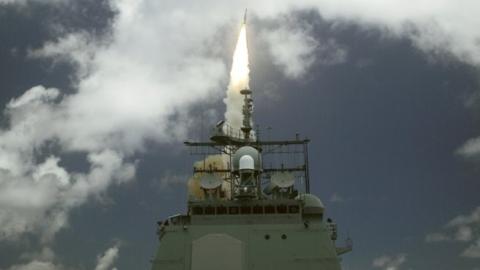This year’s missile defense debate has focused on such issues as how to develop better interceptor missiles and whether to construct a third national missile defense site on the East Coast.
Although these are important issues, an emergent requirement will be to field sufficient numbers of radars and other sensors to support these ballistic missile defense (BMD) systems. Indeed, without adequate sensor coverage to detect and track missile threats, interceptors will be flying blind and rendered useless.
The United States relies on sensors for such essential roles as searching, acquiring, detecting and tracking ballistic missiles, as well as discriminating between warheads and decoys. In effect, radars play a critical role in warning that a missile has been launched, tracking and establishing the missile’s path, guiding the interceptor to the warhead and verifying its destruction.
To achieve comprehensive and flexible missile defense coverage, the United States needs several layers of sensors. Whether deployed in the United States, on foreign soil, at sea or in space, sensors can share tracking and fire-control data with each other as well as missile shooters.
Having several types of sensors is important. They increase the defender’s confidence in being able to detect and intercept incoming missiles, reduce the risk that one type of sensor will experience a major technical flaw and decrease the effectiveness of an adversary’s countermeasures. In particular, a dense network of interlocking sensors could help the ‘kill vehicles’ discriminate between incoming warheads and other nearby objects, such as missile debris and decoys.
In this regard, the Army Navy/Transportable Radar Surveillance and Control (AN/TPY-2) plays a critical role. The AN/TPY-2 is an X-band, phased array, high-resolution radar that is capable of detecting small objects such as ballistic missiles at a range of more than 4,000 kilometers.
The radar can be used in either the forward-based mode or the terminal mode. In the first case, the forward-deployed AN/TPY-2 cues various U.S. BMD systems by detecting, discriminating and tracking enemy ballistic missiles as early as their ascent phase of flight. For example, the radar can supply fire-control data to ship-based Aegis missile defense systems found in the U.S. and other navies. Moreover, the radar coverage provided by forward-based AN/TPY-2s is more powerful than that on Aegis-equipped ships. Thus, the radar can enhance the performance of those vessels.
In terminal mode, the AN/TPY-2 provides the fire-control radar for the Terminal High Altitude Area Defense (THAAD) system, a globally transportable weapon that intercepts short, medium and intermediate ballistic missiles inside or outside the atmosphere during their final phase of flight. The THAAD combines the AN/TPY-2 radar with interceptor missiles, a truck-mounted launcher and an integrated fire control system.
THAAD is one of the most reliable systems in the U.S. inventory. Since 2005, the THAAD program has successfully completed 12 flight tests with 11-for-11 intercepts. The United States presently has four THAAD batteries. The AN/TPY-2 radars and THAAD batteries provide the Army with flexible missile defense capabilities that can be deployed to land sites in Europe, Asia and the Middle East. Other U.S. AN/TPY-2s operate in the independent, forward-based mode in support of U.S. allies, including two in Japan.
On Oct. 13, the U.S. Missile Defense Agency (MDA) received its tenth AN/TPY-2. This radar will be integrated into the U.S. Army’s fifth THAAD defense battery, which will be delivered in 2015. Separately, a sixth battery is scheduled to be delivered in 2016.
Despite these upcoming acquisitions, the number of AN/TPY-2 radars available to the United States is inadequate. The MDA originally intended to buy 18 AN/TPY-2 systems, but the number of planned purchases has since fallen to 12. Those six systems are crucial for the protection of both U.S. forces deployed abroad and friendly countries such as Israel and South Korea.
The Congress and the executive branch also need to expand efforts to sell more BMD radars to U.S. foreign friends and allies in order to keep production running after the U.S. orders are complete. If the production facilities are shut down, it could take months and billions of dollars to restart them—and we know from recent experience that missile threats can emerge with little warning.
On Oct. 27, U.S. Army General Curtis Scaparrotti, Commander of U.S. Forces Korea, warned that North Korea is in the process of mastering the miniaturization technology required to place a nuclear warhead on a mobile ballistic missile. Effectively, this means that North Korea could soon have the ability to launch a nuclear strike, without visible preparations, against U.S. forces in South Korea, Japan, Guam, Hawaii and eventually the continental United States. The only sensor system now available that can counter the immediate regional threat is the AN/TPY-2.
The new Congress must keep in mind the imperative of funding BMD sensors as well as shooters. At a time of persistent budget challenges, better sensors substantially improve the effectiveness of existing interceptors at a much lower cost than buying more or developing newer interceptors.
















